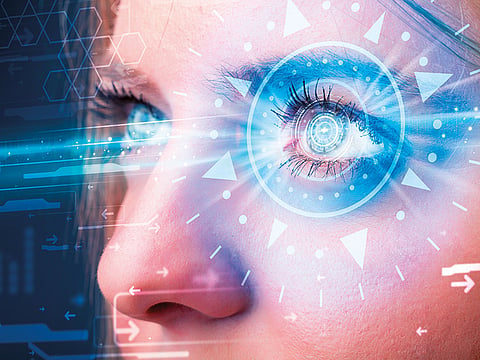Biometrics to play key role in future of banking
Eye recognition will rival fingerprint sensors to authenticate and secure mobile payments, experts say

Dubai: Biometric technologies are extending their reach in consumer electronics and are going to be utilised as part of novel identification and payment applications for both the banking and governmental markets.
ABI Research forecasts that fingerprint sensors in smartphones will surge to a 95 per cent penetration rate of smartphone shipments by 2022.
While enterprise markets aggressively adopt vein recognition technologies in physical access control applications, Dimitrios Pavlakis, industry analyst at ABI Research, said that eye recognition technologies will soon be one of the most secure modalities for consumer electronics authentication and secure mobile payments.
With each passing market quarter, he said that OEMs in the Asia-Pacific region are aggressively driving new implementations. This will fuel an exponential growth in mobile banking and payment apps as banks and financial organisations prove to be less timid when embracing new biometric implementations.
ABI Research finds that OEMs and service providers are now actively targeting the emerging IoT, smart home, and automotive segments as future growth areas for biometrics.
“Vein recognition workforce management software and access control solutions in the enterprise market depict an impressive 18 per cent five-year growth rate, boosted by market leaders like Fujitsu and Hitachi,” he said.
Facial recognition
Innovative start-ups like HYPR are making strides in improving biometric blockchain capabilities, while wearable pioneers like Nymi are triggering a domino effect with heart rate-empowered payments, he added.
But Daniel Gleeson, senior analyst for consumer technology at Ovum, said that facial recognition was not a defining feature when it was introduced in Android 4.0 way back in 2011, and there is little reason why iris scanning would be any different.
“The big problem with facial/iris scanning is the need to look directly at the handset, whereas a fingerprint reading can be authorised while the phone is en route from the pocket to in front of the face. For basic security, this extra delay will likely just frustrate consumers rather than reassure them,” he said.
Everyone has a unique iris pattern and it’s one of the most reliable ways to identify someone and it is virtually impossible to replicate. In fact, iris scanning is already widely used for many security purposes.
Gleeson said that iris scanning is more secure than basic fingerprint scanning, which can be fooled with a printer and a piece of paper. However, in 2016 several companies started using 3D fingerprint reading technology which looks for the various valleys and ridges in a fingerprint to make sure it is a real finger and not a flat picture.
“Iris scanning is likely an unnecessary extra layer of technology at the moment as far as most applications are concerned owing to the added delays it brings to everyday use. Fingerprint scanning is likely to remain the standard for mobile payments too for the same reason,” he said.
Payment authorisation
Annette Zimmermann, research director at Gartner, said these features are quite new and people don’t have much experience with it. So, it is not very important at the moment.
Samsung is using facial recognition and iris scanning to authorise payments on its new device but Zimmermann said mobile payments haven’t really taken off in many parts of the world.
However, she said authorising payments will be an added feature apart from the authentication process.
Apple acquired the facial recognition artificial intelligence company Real Face recently and Emotient, a start-up that uses artificial-intelligence technology to read people’s emotions by analysing facial expressions last year.
“Emotion sensing is something that will understand the user better. And decrypting human emotions by analysing facial expression is a growing area among tech companies. New used cases will emerge in the next couple of years,” she said.
More secure
According to analysis firm Markets and Markets, facial recognition represents a fast-growing segment of the burgeoning AI business and it is expected to grow from $3.35 billion (Dh12 billion) in 2016 to $6.84 billion in 2021.
Gleeson said that iris scanning is much more secure than basic fingerprint scanning, but even with improvement iris scanning is still more secure.
“Iris scanning will likely find a use for sensitive corporate and government communications where double and triple factor authentication may be desired,” he said.
Sign up for the Daily Briefing
Get the latest news and updates straight to your inbox



